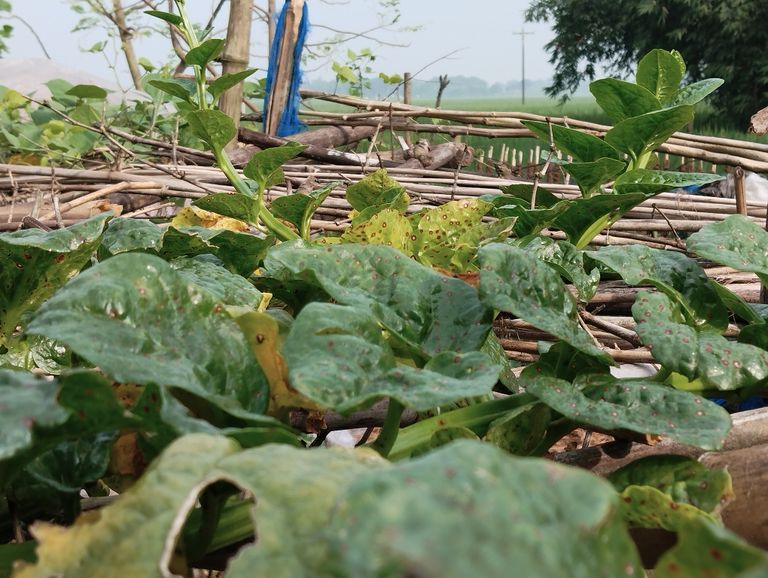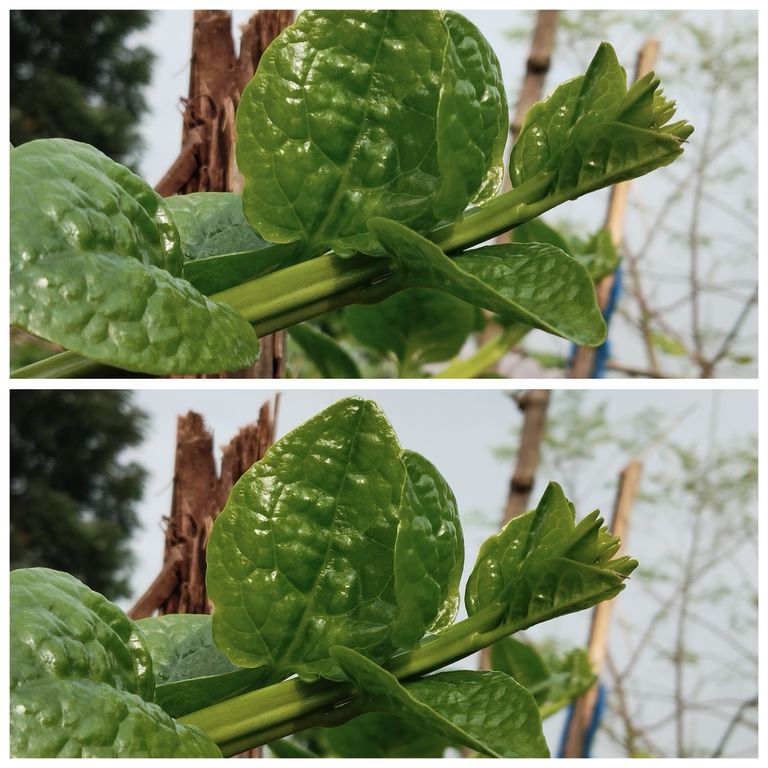
A Comprehensive Guide to Cultivating Malabar Spinach Pui Shaak.
Introduction
Malabar spinach, locally known as "Pui Shaak" in Bangladesh and parts of India, is a widely popular leafy vegetable known for its rich nutritional content and ease of growth. This perennial vine is not only tasty but also an excellent source of vitamins A, C, calcium, and iron. It thrives in hot and humid conditions, making it perfect for cultivation in tropical and subtropical regions. If you're interested in growing this nutritious vegetable, follow this detailed guide on the correct method for cultivating Pui Shaak.
- Understanding the Plant
Before diving into the cultivation process, it's essential to understand the nature of the Pui Shaak plant.
Scientific Name: Basella alba (green variety) and Basella rubra (red variety)
Common Names: Malabar spinach, Ceylon spinach, Indian spinach
Plant Type: Climbing vine, perennial in tropical regions but grown as an annual in cooler climates.
Growing Season: Thrives in warm, humid conditions, typically between spring and fall.
- Ideal Growing Conditions
To ensure optimal growth for Malabar spinach, understanding the climate, soil type, and water requirements is crucial.
Temperature: Pui Shaak grows best in warm temperatures ranging between 25°C to 35°C (77°F to 95°F). It cannot tolerate frost, making it unsuitable for very cold regions unless grown indoors.
Sunlight: The plant requires full sunlight for at least 5-6 hours daily. In regions with intense sunlight, partial shade is acceptable, especially during the hottest parts of the day.
Soil: Well-drained, fertile loam or sandy loam soil with a pH between 6.5 and 7.5 is ideal. Ensure the soil is rich in organic matter.
Watering: Malabar spinach needs consistent moisture, but waterlogging should be avoided. Drip irrigation or regular watering during dry periods helps maintain even moisture levels.
- Preparing the Soil
The success of your Pui Shaak cultivation depends heavily on soil preparation.
Soil Testing: Before planting, test the soil to check pH and nutrient levels. Add lime if the pH is too low or sulfur if it's too high.
Composting: Incorporate organic compost or well-rotted manure into the soil to enhance its fertility. Aged cow dung, chicken manure, or vermicompost can also be used to enrich the soil with essential nutrients.
Tilling: Loosen the soil up to a depth of 10-12 inches to ensure proper root development and drainage.
- Propagation Methods
Pui Shaak can be propagated either by seeds or cuttings. Both methods are widely practiced, but propagation by seeds is more common for home gardeners.
Seed Propagation:
Soak the seeds in water for 24 hours before planting to improve germination rates.
Sow the seeds directly in the prepared soil, spacing them 6-8 inches apart. The seeds should be planted at a depth of about 1 inch.
Germination typically occurs within 8-12 days.
Propagation by Cuttings:
Cut 6-8 inches of vine from a healthy Malabar spinach plant.
Place the cutting in moist soil or directly in water until roots develop.
Once rooted, transplant it to the desired growing area, spacing each plant about 12-18 inches apart.
- Caring for the Crop
Proper care and attention during the growing period will ensure a healthy, bountiful harvest.
Fertilization: Apply a balanced fertilizer (10-10-10 NPK) every 4-6 weeks during the growing season to promote leaf growth. Organic fertilizers like compost tea or fish emulsion can also be used to enhance the soil’s nutrient content.
Trellising: Since Pui Shaak is a climbing vine, it's advisable to provide support such as a trellis or bamboo stakes. The vines can grow up to 6-8 feet long, and proper support ensures better airflow and easier harvesting.
Pruning: Regularly prune the vines to encourage bushier growth. Pinch off the growing tips to prevent the plant from becoming too leggy.
- Pest and Disease Management
Malabar spinach is generally a hardy plant with minimal pest and disease issues, but some common problems can still arise.
Pests: Aphids, spider mites, and caterpillars are common pests that can attack Pui Shaak. Regularly inspect the plants for signs of infestation, and treat with neem oil or insecticidal soap as necessary.
Diseases: Downy mildew and leaf spot are the most common fungal diseases that affect Malabar spinach. Ensure proper spacing between plants to improve air circulation, and avoid overhead watering to reduce the risk of fungal infections.
- Harvesting
Pui Shaak can be harvested multiple times during the growing season.
When to Harvest: Start harvesting 40-50 days after planting when the plant has developed enough leaves. You can either harvest the entire plant or regularly pick the tender leaves and shoots.
How to Harvest: Use clean scissors or shears to cut the leaves and young shoots. Regular harvesting encourages more vigorous growth and prevents the plant from becoming overgrown.
- Post-Harvest Handling
To retain the nutritional quality and freshness of Pui Shaak, follow these post-harvest practices:
Storage: Freshly harvested leaves can be stored in the refrigerator for up to 5 days. Wrap them in a damp cloth or paper towel to retain moisture.
Usage: Pui Shaak is highly versatile in the kitchen and can be used in various dishes, including soups, curries, stir-fries, and salads. Its mild flavor and tender texture make it a great addition to any meal.
- Health Benefits of Malabar Spinach
Aside from its delicious taste, Malabar spinach offers several health benefits:
Rich in Nutrients: It is an excellent source of vitamins A, C, and B6, along with minerals like calcium, magnesium, and iron.
High in Antioxidants: The leaves contain antioxidants that help fight free radicals, promoting overall health.
Good for Digestion: The mucilaginous nature of the leaves makes them beneficial for digestive health, preventing constipation and promoting smooth bowel movements.
- Sustainable Practices for Pui Shaak Cultivation
To ensure long-term sustainability, incorporate eco-friendly farming methods.
Crop Rotation: Practice crop rotation by alternating Pui Shaak with other vegetables to prevent soil depletion and minimize pest and disease build-up.
Organic Pest Control: Use natural predators like ladybugs or introduce beneficial insects to control pest populations naturally.
Water Conservation: Implement drip irrigation or rainwater harvesting techniques to minimize water wastage.
Conclusion
Growing Pui Shaak is an excellent way to ensure a continuous supply of nutritious greens for your family while also contributing to sustainable agriculture. With the right care, proper soil management, and attention to pests and diseases, you can enjoy fresh, healthy Malabar spinach right from your garden. Whether you're a seasoned gardener or just starting, cultivating this versatile vine is a rewarding experience that can benefit your health and environment.
By following these guidelines, you can ensure that your Pui Shaak plants thrive, providing you with a nutritious and delicious harvest throughout the growing season. Happy gardening.
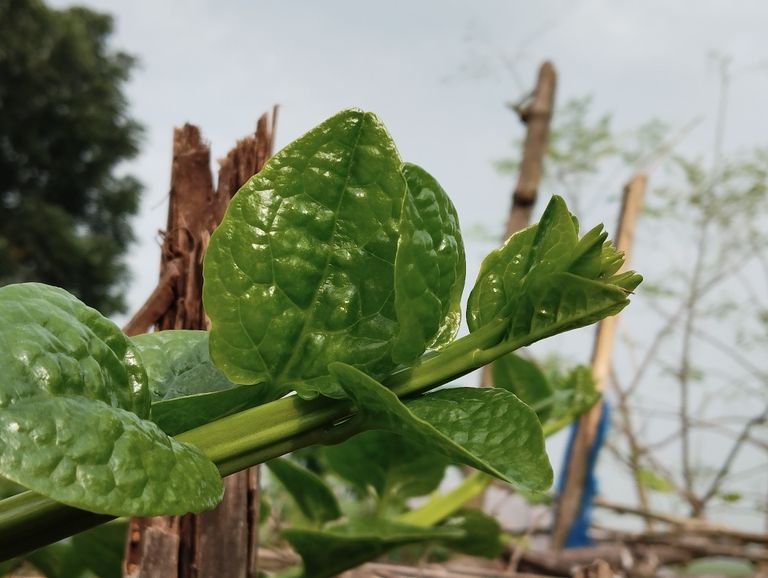

Profitable Farming of Malabar Spinach (Pui Shak)
Malabar Spinach, commonly known as "Pui Shak" in Bangladesh, is a popular leafy vegetable that grows abundantly in tropical regions. Its scientific name is Basella alba, and it is well-known for its fast growth and nutritious leaves. Due to its high demand, especially in Southeast Asia, growing Pui Shak has become a lucrative agricultural venture for small and large-scale farmers. This blog will provide an in-depth guide on how to cultivate Pui Shak profitably, the ideal conditions for its growth, and the economic benefits farmers can expect from its cultivation.
Why Pui Shak is a Profitable Crop
- High Market Demand: Pui Shak is a staple vegetable in Bangladesh, India, and other Southeast Asian countries. Its soft, succulent leaves are used in a variety of traditional dishes, making it a year-round favorite. Farmers can sell Pui Shak fresh in local markets or distribute it to urban grocery stores, ensuring consistent sales.
- Fast Growing Cycle: Pui Shak grows quickly and can be harvested multiple times in a season. This rapid turnover allows farmers to maximize their profits by harvesting several times in one season.
- Low Input Costs: The cultivation of Pui Shak requires minimal investment in seeds, fertilizer, and labor. This makes it an ideal crop for farmers looking for a low-cost, high-return option.
- Nutritious Value: Pui Shak is rich in vitamins, minerals, and fiber. Its nutritional benefits, coupled with its use in various dishes, increase its marketability.
Optimal Conditions for Pui Shak Cultivation
- Soil Preparation
Pui Shak grows best in fertile, well-drained loamy soil. The soil should be rich in organic matter, which can be enhanced by adding compost or decomposed manure. A pH range of 6.0 to 7.0 is ideal for its growth.
Farmers should prepare the land by plowing it at least two to three times to ensure a fine, tilled surface. This promotes good root development and increases plant health.
- Climate
Pui Shak thrives in warm, humid climates, making it perfect for regions like Bangladesh and India. The optimum temperature for growth is between 25°C to 35°C. Although it can tolerate some drought, consistent moisture is necessary for rapid growth and high yields. Therefore, it is advisable to cultivate Pui Shak during the monsoon season or in areas with access to irrigation.
- Planting Techniques
There are two primary methods for planting Pui Shak:
Direct Sowing: Seeds can be directly sown in the field. This method is simple and cost-effective.
Transplantation: For better yield, seeds can be sown in nurseries, and the seedlings are transplanted to the field after 3-4 weeks. Transplantation encourages stronger plants and can result in a higher yield.
Spacing should be kept at about 15-20 cm between plants and 30-40 cm between rows to allow enough room for growth.
- Watering and Irrigation
Pui Shak requires regular watering, especially during dry spells. Drip irrigation or sprinkler systems can be used to ensure even watering, which reduces water wastage and ensures consistent moisture. In areas with frequent rainfall, excess water should be drained to prevent root rot.
- Fertilization
Organic fertilizers like compost and cow dung are ideal for Pui Shak cultivation. Inorganic fertilizers such as urea and potassium nitrate can be applied as supplementary nutrients, but it is essential to avoid excessive use. An initial application of nitrogen-rich fertilizer can boost growth during the early stages.
- Pest and Disease Management
Though Pui Shak is generally hardy and resistant to many pests, aphids, caterpillars, and leaf beetles can occasionally pose problems. Regular monitoring and the use of organic pest control methods, such as neem oil or garlic sprays, can minimize these issues.
Diseases like leaf spot or fungal infections may occur in overly wet conditions. Proper spacing, ensuring good air circulation, and avoiding waterlogging will help prevent these diseases.
Harvesting and Post-Harvest Management
Pui Shak can be harvested within 35-40 days of planting. Once the plant reaches a height of 30-40 cm, farmers can start harvesting by cutting the leaves and stems.
Post-harvest management includes careful handling of the leaves to prevent damage. They should be kept in cool, shaded areas to retain their freshness before being transported to the market.
Economic Benefits of Pui Shak Cultivation
- Low Investment, High Returns
The initial investment in Pui Shak farming is relatively low compared to other crops. Seeds, organic fertilizers, and basic irrigation systems are the primary costs involved. The plant’s fast-growing nature allows for multiple harvests in a single season, increasing overall profitability.
- Multiple Revenue Streams
Aside from selling the fresh leaves, farmers can diversify by selling seeds, cuttings for transplanting, or even dried Pui Shak leaves, which are used in traditional medicine.
- Sustainability
Pui Shak farming is environmentally friendly due to its minimal need for chemical inputs and its ability to grow in a variety of soil conditions. By incorporating organic farming methods, farmers can produce healthier crops while promoting soil health.
Challenges and How to Overcome Them
- Climate Sensitivity
While Pui Shak thrives in warm climates, excessive heat or prolonged dry spells can reduce yields. Installing irrigation systems or planting during the monsoon season can help mitigate these risks.
- Market Competition
In regions where Pui Shak is widely grown, market prices can fluctuate. Farmers can overcome this by ensuring high-quality production, marketing their produce in urban areas, or processing the leaves into value-added products like dried powder or juice.
- Pest Infestation
Although Pui Shak is relatively pest-resistant, occasional infestations can harm crops. Adopting integrated pest management (IPM) techniques such as crop rotation, biological controls, and the use of organic pesticides can help farmers manage pests effectively.
Conclusion
Pui Shak cultivation offers a profitable venture for farmers due to its high demand, low input costs, and fast-growing cycle. With the right techniques, proper soil management, and pest control methods, farmers can maximize their yields and earn substantial income from this leafy green. Whether you are a small-scale farmer or managing a larger farm, investing in Pui Shak is a sustainable and profitable option worth considering.
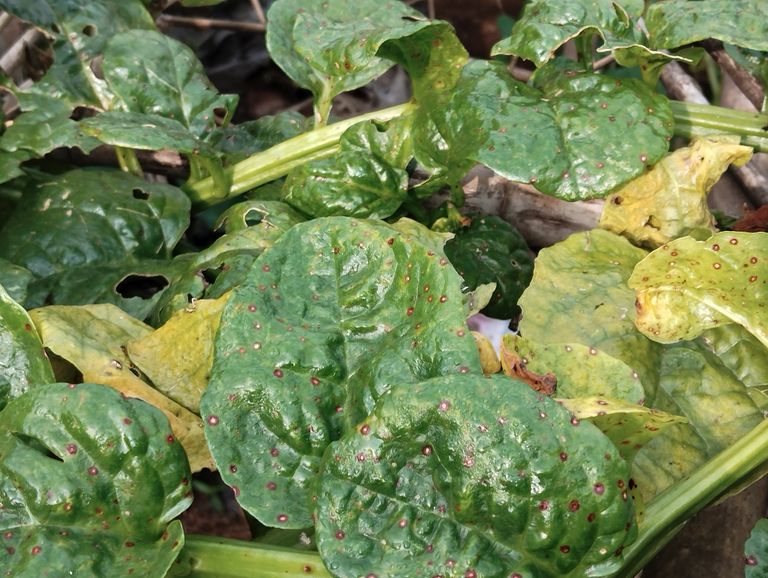
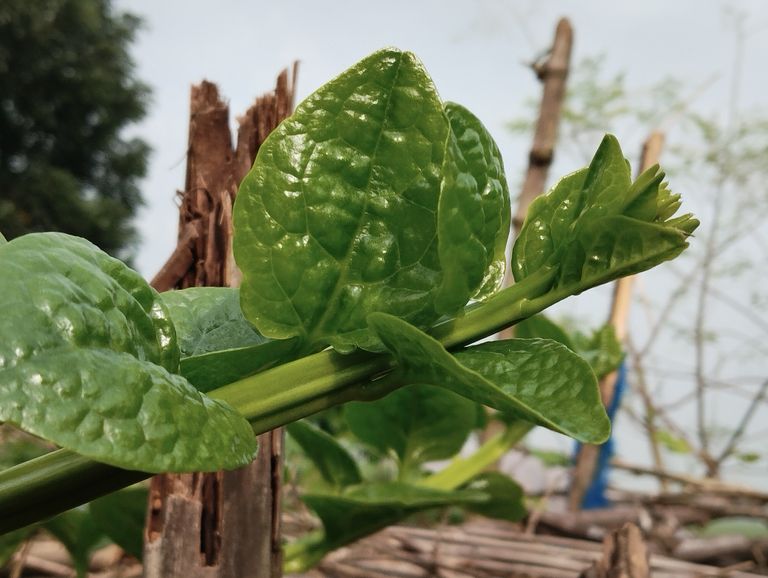
Pests and Diseases of Malabar Spinach (Pui Shak)
Malabar spinach, known as "Pui Shak" in Bengali, is a leafy vegetable widely grown in tropical regions. This heat-loving, fast-growing vine is rich in vitamins and minerals and is used in a variety of dishes. Despite its hardiness, Malabar spinach can be affected by various pests and diseases, which can significantly reduce yield and quality. In this article, we will explore the common diseases and pests that affect Malabar spinach and how to control them.
- Leaf Spot Disease (Cercospora beticola)
One of the most common diseases affecting Malabar spinach is leaf spot disease caused by the fungus Cercospora beticola. This disease is characterized by small, circular, brown spots on the leaves that may merge to form larger necrotic patches. Severe infections can cause defoliation, reducing the plant's photosynthetic capacity and leading to stunted growth.
Control Measures:
Practice crop rotation to avoid the buildup of fungal spores in the soil.
Avoid overhead irrigation, which can promote the spread of the fungus.
Remove and destroy affected plant parts to prevent the spread of the disease.
Apply fungicides like copper-based products if the infection becomes severe.
- Downy Mildew (Peronospora spinaciae)
Downy mildew is another common disease that affects Malabar spinach, especially in humid conditions. This disease is caused by the Peronospora spinaciae pathogen, which thrives in wet, cool environments. It manifests as yellow spots on the upper surface of the leaves, with a greyish or purplish mold appearing on the undersides.
Control Measures:
Ensure good air circulation around the plants by spacing them properly.
Water the plants early in the morning so that leaves can dry by midday.
Remove infected leaves and plant debris to prevent the spread of the disease.
Use fungicides containing mancozeb or metalaxyl if necessary.
- Powdery Mildew (Erysiphe spp.)
Powdery mildew, caused by the Erysiphe fungus, is a common issue in warm, dry climates. This disease presents as a white, powdery coating on the leaves, which can lead to leaf distortion, reduced growth, and diminished yield.
Control Measures:
Increase air circulation around the plants to prevent humidity buildup.
Avoid overhead watering and instead water the base of the plants.
Use sulfur-based fungicides as a preventive measure or when symptoms first appear.
- Root Knot Nematodes (Meloidogyne spp.)
Root-knot nematodes are microscopic worms that infect the roots of Malabar spinach, causing galls or knots to form. These galls restrict the plant’s ability to absorb water and nutrients, leading to poor growth, wilting, and yellowing of leaves.
Control Measures:
Rotate crops with non-host plants like corn or beans to reduce nematode populations in the soil.
Use organic amendments such as compost or neem cake to improve soil health and reduce nematode infestations.
Solarize the soil by covering it with a plastic sheet during the hottest part of the year to kill nematodes.
Resistant varieties of Malabar spinach may also be used if available.
- Aphids (Aphis gossypii)
Aphids are small, soft-bodied insects that feed on the sap of Malabar spinach plants, weakening them and transmitting viral diseases. Aphid infestations can cause yellowing and curling of leaves, stunted growth, and reduced yields.
Control Measures:
Introduce beneficial insects like ladybugs, which feed on aphids.
Spray the plants with a mixture of water and insecticidal soap to reduce aphid populations.
Remove heavily infested leaves and dispose of them away from the garden.
Use neem oil as a natural insecticide to control aphid outbreaks.
- Spider Mites (Tetranychus spp.)
Spider mites are tiny arachnids that feed on plant sap, causing stippling or speckling on the leaves. A severe infestation can lead to leaf drop and reduced plant vigor. Spider mites thrive in hot, dry conditions and can be difficult to control once established.
Control Measures:
Increase humidity around the plants by misting them with water, as spider mites prefer dry conditions.
Spray the plants with water to knock off the mites, or use insecticidal soap or neem oil.
Encourage natural predators such as predatory mites to keep spider mite populations in check.
- Flea Beetles (Altica spp.)
Flea beetles are small, black or brown beetles that feed on the leaves of Malabar spinach, creating small holes and leaving the plant looking tattered. These beetles can stunt plant growth, especially in young plants.
Control Measures:
Use floating row covers to protect young plants from flea beetles.
Handpick beetles from the plants in the early morning when they are less active.
Apply insecticides such as spinosad if the infestation becomes severe.
- Whiteflies (Bemisia tabaci)
Whiteflies are small, winged insects that suck the sap from the leaves, leading to leaf yellowing, wilting, and stunted growth. They also excrete a sticky substance known as honeydew, which can attract sooty mold.
Control Measures:
Use yellow sticky traps to capture adult whiteflies.
Spray the plants with insecticidal soap or neem oil to reduce whitefly populations.
Introduce natural predators such as lacewings and ladybugs to control whitefly infestations.
General Preventive Measures for Malabar Spinach Diseases
- Good Sanitation Practices: Always start with clean, disease-free seeds or cuttings. Ensure the garden area is free of plant debris and weeds that could harbor pests or diseases.
- Proper Spacing: Allow adequate spacing between plants to promote air circulation and reduce the spread of fungal diseases.
- Healthy Soil: Enrich the soil with organic matter and maintain proper drainage to prevent waterlogging, which can promote root diseases.
- Regular Monitoring: Inspect plants regularly for signs of pests or diseases. Early detection allows for timely intervention before the problem spreads.
- Integrated Pest Management (IPM): Use a combination of biological, cultural, and chemical control methods to manage pests and diseases sustainably.
Conclusion
While Malabar spinach is generally a hardy and easy-to-grow plant, it is not immune to pests and diseases. By practicing good garden hygiene, monitoring plants regularly, and using appropriate control methods, gardeners can minimize the impact of these issues and enjoy a healthy, productive crop of Malabar spinach.
